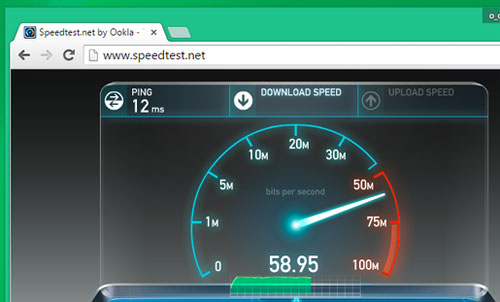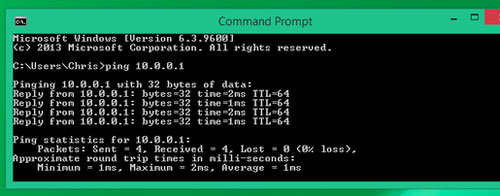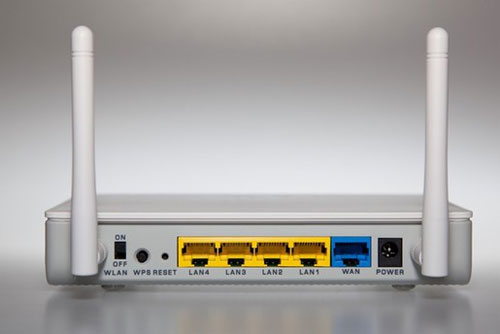When should I use Wi-Fi and when should I use wired networks?
Choosing between Wi-Fi and wired LAN (Ethernet) is the choice between convenience and speed / stability for your connection. In some cases, the difference will be enough for you to choose Ethernet.
7 things to do immediately with newly purchased computers
Obviously, you cannot connect a smartphone or tablet to the Internet via . network cable. However, choosing Wi-Fi or network ( Ethernet ) can offer a different experience for devices such as desktops, desktops, game consoles ( Xbox, PlayStation ), and video signal players. other types of large smart devices.
The difference when surfing the web, playing YouTube and downloading files is not much

Speedtest.net testing on Wi-Fi and Ethernet will give similar results
It is clear that carrying wires is faster than Wi-Fi. But, in terms of actual use, the difference may not mean much to you. Thanks to the recently released Wi-Fi standards such as 802.11n or 802.11ac, wireless networks can reach a maximum speed of up to 150 Mb / s ( standard ) or 866.7 Mb / s ( ac standard ). . Note that these are theoretical numbers, but the fact is that you no longer need to worry about Wi-Fi data download speeds when using smartphones and tablets.
However, even 802.11ac Wi-Fi networks are still significantly slower than wired networks: the high-end Cat-6 Ethernet wire can deliver a maximum connection speed of 10 Gb / s, while the wired network The common Cat-5e can carry up to 1 Gb / s connection speed.
But if you only use your devices to surf the web or even to download digital content, the difference between Wi-Fi and Ethernet will be negligible. The reason is that connecting a router / modem to the Internet will always play the " bottleneck " role in your network. Almost certainly, your Internet can't reach the 150 Mb / s limit of the 802.11n Wi-Fi standard, and so changing from Wi-Fi to a wired network won't be much different. . Tests to measure Internet speed from speedtest.net or other speed measurement applications will all confirm this.
Copy files between local machines

You should not use Wi-Fi to copy files from one PC to another
If you often have to copy files between computers / devices in the same network, choosing Ethernet instead of Wi-Fi will save you a lot of time. For example, when copying from a laptop's hard drive to a desktop hard drive via an Ethernet network using a regular Cat-5e cable, in 1 second you will copy about 125 MB of data. The copy speed in this case will actually be determined by the read / write speed of the hard drive. Obviously, the Internet connection does not play any role in this case at all.
Conversely, if you use 802.11n Wi-Fi, you will only copy over 18 MB of data. The difference here is very clear.
Gaming
The latency (latency) of the connection network is a different factor that needs to be taken into account when installing the computer network in the room. The latency parameter ( often called a "ping" name ) will have the most impact on gamers. In the game, you will need to minimize the delay from doing the action until your action is recorded by the game ( for example, since you clicked until the gun in the game is pulled ). .
In this case, you should also prioritize the wired network. If you use a Wi-Fi network, you will lose additional delay from your device to the Wi-Fi router. Network cables often have significantly lower latency and therefore will be a better choice for gamers on PC, Xbox and PlayStation.

If you check that the latency ('time') difference is too large between Wi-Fi and Ethernet, gamers should switch to using a wired network.
To accurately measure the difference in latency between Wi-Fi and home wiring, you can use Windows 'ping' command. First, connect to the router via Wi-Fi and ping the router's IP address ( usually 192.168.1.1 or 192.168.0.1 ). Then, connect to the router via the network wire and repeat the ping test. You will measure whether the delay caused by Wi-Fi is significant.
Another point to keep in mind is that, like all types of radio waves, Wi-Fi may experience interference, especially in apartment buildings with many adjacent apartments. You will also have to find reasonable locations for your router to have as wide a coverage as possible, while avoiding objects that may interfere / interfere. Different locations in the house will obviously give different Wi-Fi wave quality.
VnReview once had an article to help you improve the quality of Wi-Fi in the house. However, the fact remains that we can hardly measure the latency when using Wi-Fi to play games, and therefore the choice for users who need stable network quality will still be Ethernet.
Increase the level of convenience and aesthetics for the house

Choosing between Wi-Fi and wired LAN (Ethernet) is the choice between convenience and speed / stability for your connection. In some cases, the difference will be enough for you to choose Ethernet.
The only reason why Wi-Fi becomes the most popular intranet choice today is clear: usability. Conventional routers can cover most of your home, allowing you to connect smartphones, tablets and laptops from dining tables, beds or even toilets. On the contrary, most users will not want to go to the network from room to room. The limited number of Ethernet ports ( typically 4-5 ports ) on the router will also be another factor that users need to consider when connecting home computers.
Security
Another reason to prioritize Ethernet is security. Even the most popular Wi-Fi encryption standards such as WPA2-PSK can still be hacked. If you need absolute protection for your communications, stick with wireless routers.
Conclude
It is undeniable that the Wi-Fi connection will give you the most comfortable experience, helping to reduce the number of necessary wiring in the house and expand the range of smart devices. But, in some cases, you still need the speed and stability of the network wire.
With large devices, rarely needing to move positions such as desktops, game consoles or set-top boxes ( TV signals ), you can connect to the network to enjoy the experience. more stable number. Network devices now also allow you to use a combination of Wi-Fi and Ethernet, so you can wire your PC to your PC and enjoy the convenience of Wi-Fi with your smartphone, tablet.
In short, Ethernet and Wi-Fi all have their own strengths, but sometimes the difference may not be much - consider your use cases and perform speed / latency measurements to determine Determine as accurately as possible!
You should read it
- How to Convert Ethernet Connection to WiFi
- This is why you should plug in the network cable when playing games instead of using wifi
- What are the benefits of segmenting an Ethernet network?
- Test Ethernet network knowledge
- Ethernet cable and how it works
- How to Set Up a Wired Network (Ethernet)
- What to do if Ethernet connection keeps dropping on Windows 10/11?
- What is CAT 6 network cable and how is it different from the CAT 5e network cable?
May be interested
- Instructions for installing a wired security camera system
 basically, this process is not simple, but the benefits that it brings will be totally worth the effort you spend.
basically, this process is not simple, but the benefits that it brings will be totally worth the effort you spend. - Secure WiFi in enterprise environment from basic steps
 wifi is an entry-point (an entry point) that hackers can use to infiltrate your network without stepping into your company's headquarters, because wireless networks are more vulnerable to eavesdropping than wired networks. this makes network administrators more diligent in the security of wifi networks.
wifi is an entry-point (an entry point) that hackers can use to infiltrate your network without stepping into your company's headquarters, because wireless networks are more vulnerable to eavesdropping than wired networks. this makes network administrators more diligent in the security of wifi networks. - Things to know before installing a wired security camera system
 there is the fact that wired security cameras are always much more reliable and reliable than wi-fi wireless security cameras.
there is the fact that wired security cameras are always much more reliable and reliable than wi-fi wireless security cameras. - Top 10 social networks to replace Facebook (part 2)
 in the previous section of the article, we introduced the 5 largest social networks today and can easily replace the facebook giant. the following section will continue to suggest 5 social networks are growing in the world and will bring you extremely new experiences.
in the previous section of the article, we introduced the 5 largest social networks today and can easily replace the facebook giant. the following section will continue to suggest 5 social networks are growing in the world and will bring you extremely new experiences. - How to share Internet Ethernet connection for mobile devices
 after all, the wired ethernet network is still more popular, and you can convert that wired ethernet connection to a wi-fi connection that all your mobile devices, from smartphones, phones. photos, laptops, until game consoles ... can be used.
after all, the wired ethernet network is still more popular, and you can convert that wired ethernet connection to a wi-fi connection that all your mobile devices, from smartphones, phones. photos, laptops, until game consoles ... can be used. - How to fix Laptop not getting wired network
 normally laptops we will use wireless connection to access the network for convenience, but in some cases we still have to use wired lan to connect more stable.
normally laptops we will use wireless connection to access the network for convenience, but in some cases we still have to use wired lan to connect more stable. - 9 misunderstand about social networks
 today social media has changed the way we sell, marketing and public relations - but there are still many misconceptions and misunderstandings about social networks (mxh). here are the 9 most common misunderstandings about social media and related research.
today social media has changed the way we sell, marketing and public relations - but there are still many misconceptions and misunderstandings about social networks (mxh). here are the 9 most common misunderstandings about social media and related research. - Ethernet cable and how it works
 ethernet cables are one of the most common types of network cables used for wired networks. ethernet cables connect devices to each other in local area networks like computers, routers and switches.
ethernet cables are one of the most common types of network cables used for wired networks. ethernet cables connect devices to each other in local area networks like computers, routers and switches. - Why many people choose to use wireless technology, away from wired devices
 many people choose to go all wireless because they hate messy wires and the experience is really great.
many people choose to go all wireless because they hate messy wires and the experience is really great. - How to Set Up a Wired Network (Ethernet)
 today's tipsmake will show you how to connect your computer directly to a router via ethernet cable, as well as how to set up ethernet settings on windows and mac computers.
today's tipsmake will show you how to connect your computer directly to a router via ethernet cable, as well as how to set up ethernet settings on windows and mac computers.










 7 soft skills needed by an IT worker
7 soft skills needed by an IT worker How to check the Adobe Flash Player version in the browser
How to check the Adobe Flash Player version in the browser Customize the login screen background on Windows 7
Customize the login screen background on Windows 7 How to delete music on Nokia Lumia 920
How to delete music on Nokia Lumia 920 How to help users on iOS 8
How to help users on iOS 8 Use BlackBerry Passport for the first time
Use BlackBerry Passport for the first time